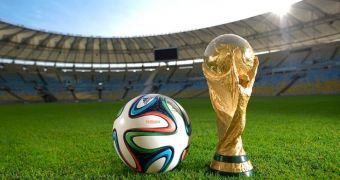Those working under the assumption that football is just a game might want to reconsider their opinion after learning that, apart from beer, quite a lot of scientific thinking goes into ensuring the success of one World Cup or another.
Not to beat about the bush, it turns out that physics experts with the University of Adelaide in Australia recently took the time to study the makeup of the 2014 FIFA World Cup ball, i.e. the Brazuca.
After completing their investigations, the researchers proudly announced that, when compared to the 2010 FIFA World Cup ball, i.e. the Jabulani, the Brazuca should be fairly predictable when on the field.
As detailed on the official website for the University of Adelaide, the Brazuca is expected to move in a more predictable manner due to the fact that, unlike the Jabulani, it is a rather rough ball. This is due to the fact that it has deep grooves.
“The Brazuca has very deep grooves – it's much rougher than Jabulani – and this creates a different pattern of air flow around the ball,” Professor Derek Leinweber with the University's School of Chemistry and Physics said in a statement.
“The Brazuca, with its deeper grooves, hits that turbulent air flow at a lower speed with the result that the ball is much more predictable. In many ways, it's a return to the aerodynamics of the old 32-panel ball,” the specialist went on to explain.
By comparison, the Jabulani's smaller grooves, together with the ridges it had on its surface, meant that the ball hit turbulent air flow at considerable speeds. It is believed that this is the reason why, on its way to the net, the Jabulani sometimes had an erratic flight path.
If the University of Adelaide scientists behind this research project are right and the Brazuca will in fact turn out to be more predictable then the Jabulani, chances are that keepers will like it more than they did the 2010 World Cup ball.
“Keepers facing players of the calibre of Messi, Cristiano Ronaldo or Neymar are going to be glad that it's Brazuca coming at them rather than Jabulani,” PhD candidate Adrian Kiratidis commented on the outcome of this study.
In order to assess the behavior of the Brazuca when compared to that of the Jabulani, scientists used information obtained with the help of wind tunnels, videos showing the two balls in motion, and data concerning the physics of air flows.

 14 DAY TRIAL //
14 DAY TRIAL //